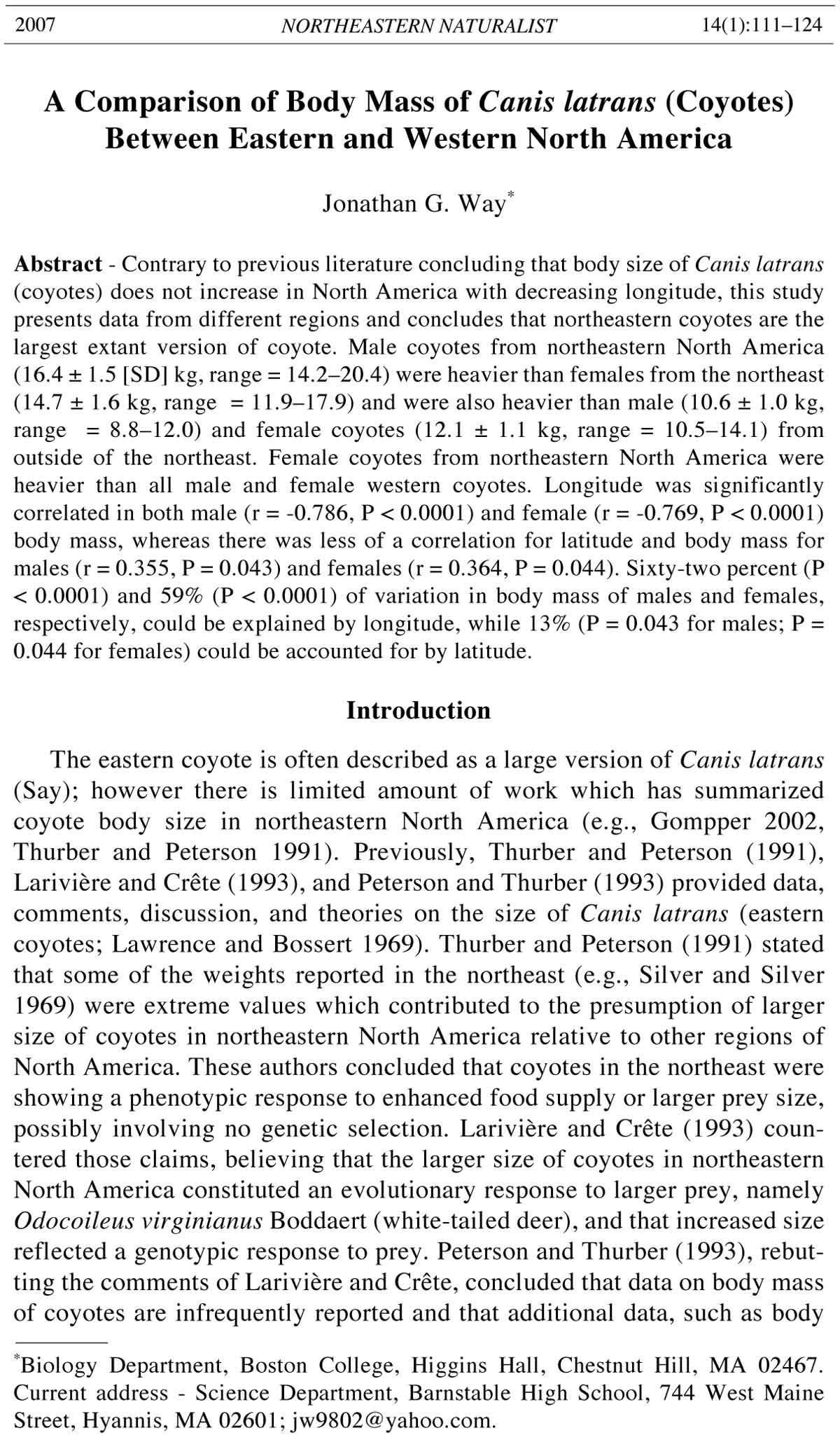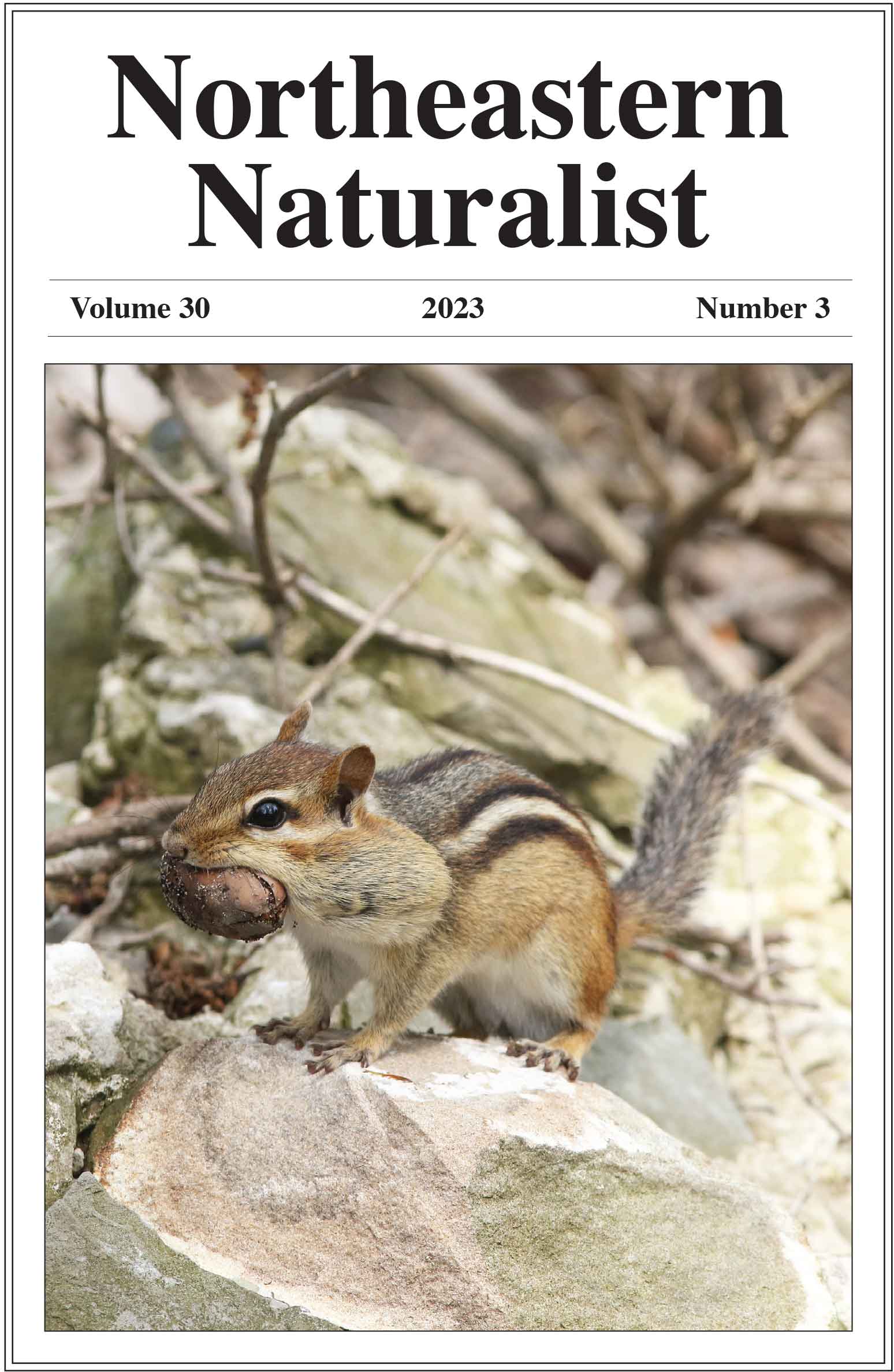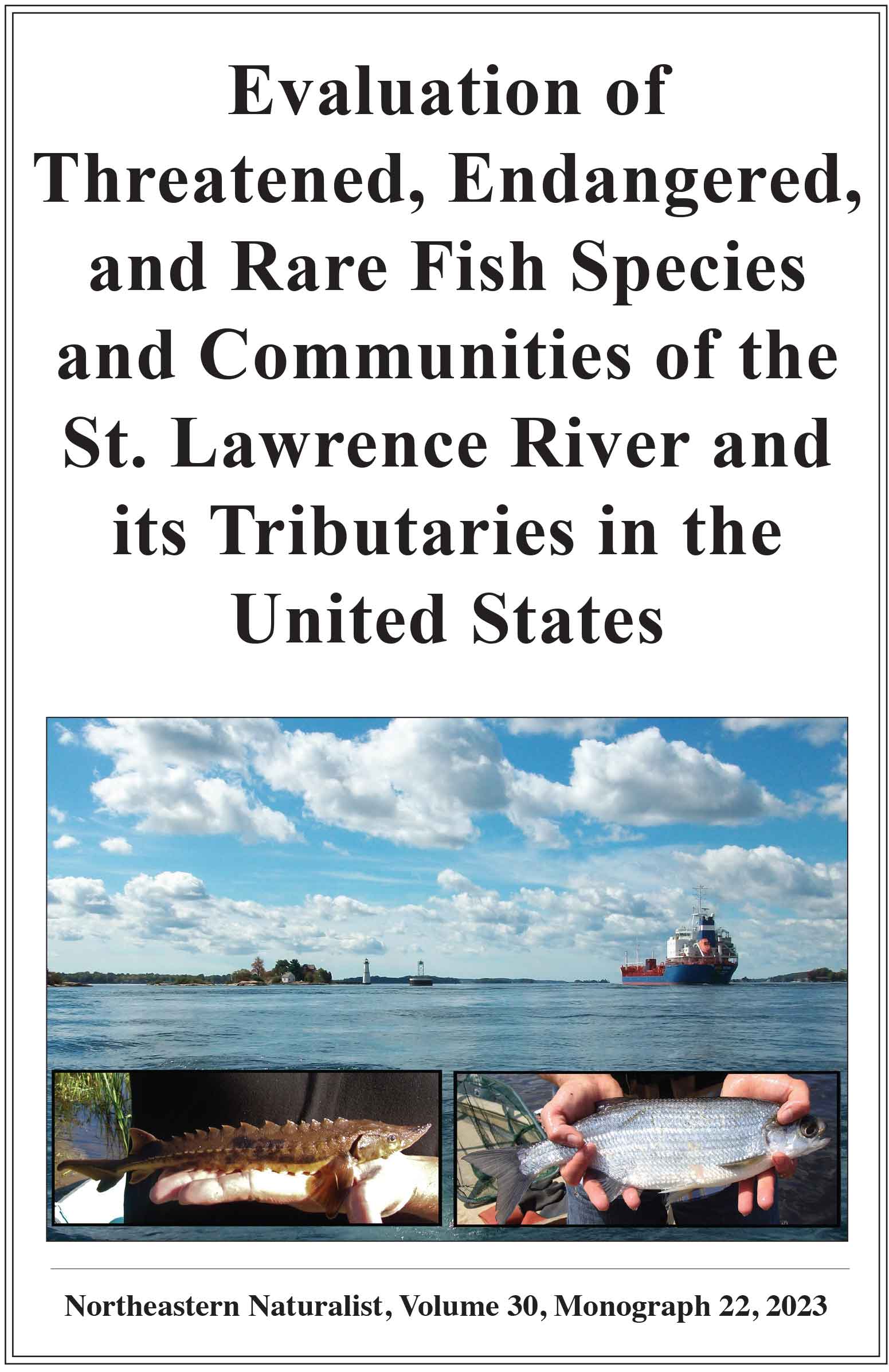2007 NORTHEASTERN NATURALIST 14(1):111–124
A Comparison of Body Mass of Canis latrans (Coyotes)
Between Eastern and Western North America
Jonathan G. Way*
Abstract - Contrary to previous literature concluding that body size of Canis latrans
(coyotes) does not increase in North America with decreasing longitude, this study
presents data from different regions and concludes that northeastern coyotes are the
largest extant version of coyote. Male coyotes from northeastern North America
(16.4 ± 1.5 [SD] kg, range = 14.2–20.4) were heavier than females from the northeast
(14.7 ± 1.6 kg, range = 11.9–17.9) and were also heavier than male (10.6 ± 1.0 kg,
range = 8.8–12.0) and female coyotes (12.1 ± 1.1 kg, range = 10.5–14.1) from
outside of the northeast. Female coyotes from northeastern North America were
heavier than all male and female western coyotes. Longitude was significantly
correlated in both male (r = -0.786, P < 0.0001) and female (r = -0.769, P < 0.0001)
body mass, whereas there was less of a correlation for latitude and body mass for
males (r = 0.355, P = 0.043) and females (r = 0.364, P = 0.044). Sixty-two percent (P
< 0.0001) and 59% (P < 0.0001) of variation in body mass of males and females,
respectively, could be explained by longitude, while 13% (P = 0.043 for males; P =
0.044 for females) could be accounted for by latitude.
Introduction
The eastern coyote is often described as a large version of Canis latrans
(Say); however there is limited amount of work which has summarized
coyote body size in northeastern North America (e.g., Gompper 2002,
Thurber and Peterson 1991). Previously, Thurber and Peterson (1991),
Larivière and Crête (1993), and Peterson and Thurber (1993) provided data,
comments, discussion, and theories on the size of Canis latrans (eastern
coyotes; Lawrence and Bossert 1969). Thurber and Peterson (1991) stated
that some of the weights reported in the northeast (e.g., Silver and Silver
1969) were extreme values which contributed to the presumption of larger
size of coyotes in northeastern North America relative to other regions of
North America. These authors concluded that coyotes in the northeast were
showing a phenotypic response to enhanced food supply or larger prey size,
possibly involving no genetic selection. Larivière and Crête (1993) countered
those claims, believing that the larger size of coyotes in northeastern
North America constituted an evolutionary response to larger prey, namely
Odocoileus virginianus Boddaert (white-tailed deer), and that increased size
reflected a genotypic response to prey. Peterson and Thurber (1993), rebutting
the comments of Larivière and Crête, concluded that data on body mass
of coyotes are infrequently reported and that additional data, such as body
*Biology Department, Boston College, Higgins Hall, Chestnut Hill, MA 02467.
Current address - Science Department, Barnstable High School, 744 West Maine
Street, Hyannis, MA 02601; jw9802@yahoo.com.
112 Northeastern Naturalist Vol. 14, No. 1
masses from new areas of the northeast or new genetic analyses, were
needed to evaluate whether the northeastern coyote was the largest extant
version of coyote.
Body mass is a useful index of size differences among regions because
this metric is more commonly reported in the literature than other measurements,
such as body length. Thus, a large sample of body masses from
different regions should give a good approximation of a species size
throughout its range. However, there is not a comprehensive analysis of
coyote body masses in the northeast, making it difficult to accurately compare
to other regions (Thurber and Peterson 1991). Recently, several authors
have reported sizes of coyotes in northeastern North America conducted
during ecological and/or morphological studies (Table 1). The objective of
this study was to present data on coyote body weights reported from areas
of northeastern North America and compare these weights to published
studies from other regions within the coyote’s range. The null hypothesis
was that there is no difference in body mass between coyotes in eastern
North America and coyotes from other regions of the species’ geographic
range in North America.
Methods
I obtained body mass values via three ways. First, I analyzed the literature
for published weights on coyote body mass throughout its range, but excluded
data from the southeastern United States. The potential of coyotes originating
from other areas (i.e., being introduced there; Hill et al. 1987), or being of
questionable taxonomic status due to potential hybridization with Canis rufus
Audubon and Bachman (red wolf) (Gipson 1978, Lydeard and Kennedy 1988,
Nowak 1978), precluded analysis for the southeastern US. Second, I attempted
to contact furbearer biologists from Rhode Island, Connecticut, New
York, New Jersey, and Pennsylvania because there is a paucity of data
published on coyote body weights from those states. Third, I obtained samples
from eastern Massachusetts, including study sites in north Boston and Cape
Cod (J.G. Way, unpubl. data). In my study area, I averaged weights for repeat
captures (a capture was either dead [e.g., road-kill] or alive [e.g., trapped and
tranquilized]; 5 females and 5 males including 6 radio-collared adults that
died—i.e., the 2nd measurement) before including them in the analysis for
average mass. Many studies, including the eastern Massachusetts samples
reported herein (Table 1), reported live weights of coyotes taken opportunistically
during ecological investigations of coyote behavior (e.g., Bowen 1982,
Person 1988, Way 2000). Yet other studies analyzed dead (mostly trapped)
coyotes for specific reasons such as studying body composition (Huot et al.
1995, Poulle et al. 1995) or condition (Dumond and Villard 2000).
For the studies where I obtained body-mass values, I retained those with
10 animals reported to reduce the effects of small sample sizes. Because I
excluded studies with weights of < 10 individuals, some cited values from
northeastern North America (Kendrot 1998, Messier and Barrette 1982,
2007 J.G. Way 113
Table 1. Reported body masses (kg) of coyotes from different regions of North America. M =
male, F = female, T = total, and NA = not available. An attempt was made to only include values
from coyotes known to be 2 yr, but because data from yearlings measured during winter were
potentially included, these body masses should be treated as minimum averages.
Location M F Source Comments
Northeastern coyotes
Cape Cod/E. MA 17.9 16.0 The author and Way 2000 N = 18M, 17F; 12.3–25
kg for M; 1F = 25.1
Rhode Island 16.6 15.3 C. Brown, RI Fish and N = 21M, 15F; max M =
Wildlife, Wakefield, RI 20.9 kg; F = 21.4 kg
New Hampshire 20.4 17.9 Silver and Silver 1969 N = 15M, 13F
Vermont 17.8 16.6 Person 1988 N = 10M, 7F; max =
21.4 kg
W. MA/Vermont 16.9 14.5 Lorenz 1978 N = 24M, 18F; 5M,1F
19 kg, max = 25 kg M
Adirondacks, NY 14.2 11.9 Brundige 1993 N = 19T
Maine 15.9 14.5 Hilton 1976 N = 37M, 22F
Maine 15.8 13.7 Richens and Hugie 1974 N = 28M, 20F
Maine–Down East 17.3 15.5 Harrison 1986 N = 60T; max = 20.5 kg
SE Quebec–Gaspe 16.0 14.1 Poulle et al. 1995 N = 28M, 21F; autumn–
winter samples
Ontario 14.5 NA Kolenosky 1971 N = 19M
E. New Brunswick 14.6 13.1 Dumond and Villard 2000 N = 44M, 43F
NB/Nova Scotia 16.6 15.2 Moore and Millar 1986 N = 50M,23F
Nova Scotia 15.4 12.6 Sabean 1993 N = 85M,44F; max =
21.7 kg M
Nova Scotia 16.5 13.7 Parker 1995 N = 89T; max = 25.9 kg M
Prince Edward Is. 16.0 15.0 Parker 1995 N = 90T; max = 25 kg M
Outside of northeastern North America
Western US 11.4 10.5 Bekoff and Jameson 1975 A general average of
western coyotes taking
sexual dimorphism into
account.
Idaho 10.7 8.9 Barnum et al. 1979 N = 56T
New Mexico 11.6 9.5 Windberg et al. 1997 N = 21M, 13F
New Mexico 11.1 10.1 Young and Jackson 1951 N = 446M, 383F; max =
18.6 kg M; 15 kg F
NE Arizona 10.5 8.8 Witham 1977 N = 10M, 7F; max = 12.7
kg M
Tucson, AZ 11.9 10.2 Grinder and Krausman 2001 N = 6M, 7F; max = 15.5 kg
North-coastal CA 11.6 10.4 Neale et al. 1998 No N given
California 10.9 9.8 Hawthorne 1971 No N, cited from 3 sources
within
Kansas 13.3 11.6 Gipson and Kamler 2002 N = 5M,8F
Kansas 14.1 11.8 Gier 1968 No N, cited from 2 sources
within
Texas 12.6 10.5 Young and Jackson 1951 N = 46M, 38F
Oklahoma 11.9 NA Young and Jackson 1951 N = 196M
Iowa 13.0 11.4 Andrews and Boggess 1978 No N given
N. Minnesota 12.5 11.5 Berg and Chesness 1978 N = 204T
Yellowstone N.P. 13.6 11.8 Crabtree and Sheldon 1999 No N, but many captures
(pers. comm.)
Jasper N.P., AB 12.1 11.5 Bowen 1982 N = 19M, 20F
Kenai, AK 12.9 11.1 Thurber and Peterson 1991 N = 26M, 28F
114 Northeastern Naturalist Vol. 14, No. 1
Tremblay et al. 1998) and Colorado (Silver and Silver 1969) were omitted.
Some studies that I included did not report sample sizes; however, the text
(e.g., a region-wide study, or weights reported from trappers) indicated that
they met my criteria for inclusion in this report.
To be consistent, because coyotes in northeastern North America do not
mature until two years of age (Harrison 1992), I attempted to include values
from coyotes known to be 2 yr, based on body size and dentition (Bekoff
and Jamieson 1975, Person 1988, Richens and Hugie 1974). However, data
from yearlings measured during winter were potentially included. I did not
take the weight of stomach contents into account (Larivière and Crête 1993),
assuming that my large sample size (Table 1) would mitigate any variation
that existed. The season that coyotes were weighed may confound results
because coyotes have been shown to be 27–28% heavier during autumn–
winter than spring–summer (Poulle et al. 1995). Therefore, if reported seasonally,
I excluded data during the pup-rearing period (April–September;
Way et al. 2001) to reduce variation between studies. This criterion caused
me to withdraw the data reported by Huot et al. (1995), which were collected
predominately during summer.
I used the average body mass of male and female coyotes from each
reported study (Table 1) for comparison purposes; thus, each study represented
the sampling unit (Thurber and Peterson 1991). Standard deviations
of coyote body weights were not reported in many studies (e.g., Silver and
Silver 1969), which precluded me from statistically comparing these data
(e.g., New Hampshire) to other studies. Instead, I numerically compared the
average masses reported for recently established populations in northeastern
North America east of longitude 80° (recent range expansion described in
Parker [1995] as New England, New York, New Jersey, Pennsylvania,
Ontario, and Quebec) to the rest of coyote range. I did not conduct a
statistical comparison between coyotes in the northeast versus coyotes from
other areas because the line dividing the data was arbitrary. Rather, I correlated
coyote body mass with longitude (Fig. 1) and latitude (Fig. 2) using
two-tailed bivariate Pearson correlation coefficients (SPSS Inc., Chicago,
IL) tests. Because the data were interval-based, I used the Pearson test rather
than a non-parametric test for ordinal and/or rank data, such as Spearman’s
rho (Hinkle et al. 1998). To analyze the proportion of variance in body mass
caused by latitude or longitude, I determined the coefficient of determination
(r2) and considered P < 0.05 to represent statistical significance.
I obtained latitude and longitude for each study site by one of three criteria:
using coordinate values reported from a given study; using an internet website
(www.terraserver-usa.com) to estimate an approximate midpoint area from
where measurements were taken (e.g., for measurements taken throughout a
large western state in the US, I used the geographic center of that state as the
coordinate value for the given study); and where specific townships or counties
were reported for a given study, I used the internet (www.google.com,
www.hometownusa.com, www.hometowncanada.com, or www.terraserverusa.
com) to locate the nearest coordinates to the study site.
2007 J.G. Way 115
Results
Mean (± SD) weights of male coyotes from northeastern North America
from 16 studies averaged 16.4 (± 1.5) kg (range = 14.2–20.4), whereas
females from 15 of these studies averaged 14.7 (± 1.6) kg (range = 11.9–
17.9), or 90% of the mean weight of males. Published weights of male
Figure 1. Coyote body masses (kg) in different regions of North America correlated
with longitude: (a) male coyote body masses and longitude; (b) female coyote body
masses and longitude.
116 Northeastern Naturalist Vol. 14, No. 1
coyotes outside of northeastern North America from 17 studies averaged
12.1 (± 1.1) kg (range = 10.5–14.1), whereas females from 16 of these
accounts averaged 10.6 (± 1.0) kg (range = 8.8–12.0), or 88% of the mean
weight of western males (Table 1). Male and female coyotes from outside of
the northeast averaged 74% and 65% of the mass of male coyotes and 82%
and 72% of the mass of female coyotes from the northeast.
Figure 2. Coyote body masses (kg) in different regions of North America correlated
with latitude: (a) male coyote body masses and latitude; and (b) female coyote body
masses and latitude.
2007 J.G. Way 117
Eight of the 16 (50%) studies reported on eastern coyotes approximated
the values reported by Silver and Silver (1969), with the ranges in these
studies approaching ( 0.5 kg) or overlapping with the mean mass reported
by Silver and Silver. Although not all studies reported ranges in coyote
weights, 8 authors (excluding data provided by Kendrot [1998]) documented
maximal weights of individual male coyotes 20 kg, while 4 reported
females 19 kg. Four studies reported coyotes 25 kg, including 1 female in
Massachusetts (Table 1).
Significant correlations existed between male and female body mass and
longitude (Fig. 1) and latitude (Fig. 2). Most of the variation in coyote body
mass can be explained by longitude, with bigger coyotes occurring in eastern
North America (Fig. 1a, b); yet some of the difference in body mass could be
elucidated by latitude with coyotes generally larger when further north (Fig.
2a, b; Table 1—although note Alaska as an exception). Sixty-two percent
(r2 = 0.618, P < 0.0001) and 59% (r2 = 0.591, P < 0.0001) of variation in body
mass of males and females, respectively, could be explained by longitude,
while 13% (r2 = 0.126, P = 0.043 for males; r2 = 0.132, P = 0.044 for females)
could be accounted for by latitude.
Discussion
Data presented in this paper provide further evidence that coyotes inhabiting
northeastern North America are larger than their conspecifics from
other regions (Nowak and Paradiso 1983, Wayne and Lehman 1992). They
are clearly heavier than the nearest subspecies of coyote, C. l. thamnos,
found in the midwest United States (Berg and Chesness 1978, Parker 1995,
Table 1). While much research on coyotes has been conducted, weights of
adult coyotes should continue to be reported. For example, it was difficult to
locate published studies from many locations in their western range. I
predict that if more sources were obtained from other regions (e.g., the
desert southwest where coyotes are smaller; Parker 1995) the difference
between coyotes in the northeast and other coyote populations would have
been even more disparate. Furthermore, coyotes from southern New England
appeared to be slightly heavier than ones from northern New England.
However, it is also important to stress that masses, although the most
commonly reported body measurement, should be treated with caution.
Variability in body mass can be attributed to many factors unrelated to the
taxonomy of the animal, such as fullness of stomach, animal condition,
season, hydration, reproductive success, and age.
Size dimorphism was observed between sexes; males were 11% and 14%
(in the east and outside the east, respectively) heavier than females. This is
consistent with the literature for canids (e.g., Bekoff 1977, Kennedy et al.
2003, Parker 1995), yet coyote females in eastern North America were 21%
heavier than male coyotes from outside the northeast. In fact, coyotes from
the northeast were so much larger than the typical reported weight for the
species, they would classify in a different size category (based on body
118 Northeastern Naturalist Vol. 14, No. 1
masses) than western coyotes in many review studies with carnivore size
guilds. For example, Sillero-Zubiri and Laurenson (2001) excluded coyotes
because they reported only large carnivores with a mass of 15 kg, an
average that northeastern coyotes of both sexes exceeded. Moehlman (1989)
classified coyotes in the medium-sized canid range, with > 13 kg as the
largest category, a value surpassed by every site reporting weights of male
coyotes in the northeast and by 13 of 15 (87%) sites reporting weights of
female coyotes in the northeast. Furthermore, some coyotes in the northeast
would be placed in the large-sized (> 20 kg) category for canids reported by
Johnson et al. (1996). Wayne and Lehman (1992) claimed that all canids
> 20 kg, a value that northeastern coyotes regularly exceed (Table 1), were
identified as wolves in Minnesota and southeastern Canada. Northeastern
coyotes approached the size of wolf-coyote hybrids (20.5 ± 0.6 kg for males,
17.5 ± 0.5 females) in southeastern Ontario (Sears et al. 2003).
Thurber and Peterson (1991) stated that coyotes in the northeast were
showing a phenotypic response to enhanced food supply or larger prey
size. However, others cite that due to a decreased food supply (both large
and small prey), coyotes in eastern North America exist at lower densities,
have larger home ranges, and generally live in smaller groups than
their counterparts in other areas (principally within their historic range
[i.e., the area they lived in before their range expansion in the late 1800s;
Parker 1995] of the western United States) (Harrison 1992, Parker 1995,
Patterson and Messier 2001, Way et al. 2002). Larivière and Crête (1993)
believed the larger size of eastern coyotes constituted an evolutionary
response to larger prey, and that increased size reflected a genotypic
response to prey. However, white-tailed deer are widespread and abundant
in most of the United States (Warren 1997), and coyote body size,
where reported, is not larger in other areas. Detailed controlled studies of
prey abundance and body size between study sites and regions of the
coyote’s range need to test the plausibility of the phenotypic response
(Thurber and Peterson 1991) and genetic selection (Larivière and Crête
1993) theories. Additionally, knowledge of prey body size and any variation
between regions should also be included in future comparisons, as
coyotes might be smaller where deer are smaller. The high percentage of
deer in the diet of coyotes in the northeast (Ballard et al. 1999, Harrison
1992, Harrison and Harrison 1984, Litvaitis and Harrison 1989, Major
and Sherburne 1987, Patterson and Messier 2001) could lead to selection
for larger body size relative to their historical range where small–medium
sized animals (Crabtree and Sheldon 1999), insects, and fruits (Andelt
1985) dominate the diet.
Coyotes in the northeast do not appear to be coy-dogs (i.e., a hybrid of a
coyote and domestic dog) because they consistently gave birth in early
April, which is when wild canids normally whelp (Harrison and Gilbert
1985, Parker 1995, Way et al. 2001). Mengel (1971) found that coy-dogs
have a phase-shifted reproductive cycle, typically breeding during the fall
2007 J.G. Way 119
and whelping in mid-winter, both of which are 2–3 months prior to the
annual cycle displayed by coyotes. Because coyotes normally only breed
during mid-to-late winter, their reproductive cycles do not overlap with coydogs.
Furthermore, the prospect of a female coy-dog raising offspring in
mid-winter in northeastern North America is slim, especially considering
that male coyotes are not in reproductive condition during the fall, indicating
that the sire would have to be a domestic dog, which does not contribute to
pup-rearing. Mengel (1971) concluded that introgression of Canis lupus
lycaon Schreber (gray wolf) genes into a coyote population seems much
more likely to explain the peculiarities of the larger coyotes in New England.
However, domestic-dog genes have been incorporated into coyotes in the
southeastern United States (Adams et al. 2003b). Additional research,
including understanding the behavior of coyotes in the southeast (e.g.,
documenting when they whelp), is needed to elucidate the effects of coydogs
on wild Canis populations.
Genetic data is sorely needed to clarify the origins of coyotes in the
northeast since this analysis might give insight into the larger body mass
of coyotes in that region. Thurber and Peterson (1991) stated that wolfcoyote
hybridization has been verified only in captivity where behavioral
barriers may have artificially deteriorated (Kolenosky 1971, Schmidtz
and Kolenosky 1985a). It is well documented (Kolenosky 1971;
Kolenosky and Standfield 1975; Schmitz and Kolenosky 1985a, b;
Schmitz and Lavigne 1987; Theberge and Theberge 2004) that wolves
found near eastern coyote habitat (i.e., southern Ontario) are smaller (ca.
25–30 kg) than in other areas such as Alaska (Mech et al. 1998, Thurber
and Peterson 1991), Minnesota (Mech 2000), Yellowstone National Park
(Phillips and Smith 1996), and the Rocky Mountains (Pilgrim et al. 1998)
where the two species are sympatric. This perhaps could influence hybridization
as wolves may not be as dominant and aggressive towards
coyotes (see Crabtree and Sheldon 1999, Peterson 1995) where they are
closer in physical stature—i.e., southern Ontario. Schmitz and Kolenosky
(1985b) stated that hybridization between the coyote and wolf may have
resulted when there was a breakdown in reproductive barriers such as
interspecific agonistic behavior and differing habitat preferences that normally
maintained these species in reproductive isolation. As Moore and
Parker (1992) indicated, this shift may have occurred at the turn of the
century when wolves were being exterminated from the northeastern US
and southeastern Canada and coyotes were colonizing these regions. Further,
Wilson et al. (2000, 2003) reported that the wolves found in southeastern
Canada may be the same species as red wolf, or Canis lycaon as
they proposed. This wolf is thought to be more closely related to the
coyote than the gray wolf because both are theorized to have evolved in
the New World versus the Old World origin of the gray wolf. Thus, the
genetic similarity of the coyote and Canis lycaon might facilitate hybridization,
especially when populations are low in an area. In fact, the
120 Northeastern Naturalist Vol. 14, No. 1
biggest threat currently facing the red wolf in the southeast US is hybridization
with coyotes colonizing the periphery of the North Carolina red
wolf recovery area (Adams et al. 2003a).
This study found that the coyotes in northeastern North America are
larger than coyotes from other regions. There was a wide range of weights
reported for coyotes throughout northeastern North America, and all sites in
the northeast averaged higher than for studies from western North America.
Although Bergmann’s rule (i.e., larger body size with increasing latitude)
has been posited to explain the larger body sizes of mammals in colder
climates, findings from this study indicate that longitude accounts for > 4
times the amount of variation in coyote body mass than does latitude. This
suggests that phenotypic selection in response to use of large ungulates and/
or possible genetic influences of hybridization with southern populations of
wolves might explain larger relative body sizes of coyotes in eastern North
America in comparison to similar latitudes in the west. A comprehensive
genetic analysis would provide additional insight into taxonomy of this
unique canid and the reasons for larger body sizes in the northeastern portion
of the coyote’s geographic range.
Acknowledgments
This study would not have been possible without the support from Dr. L.Venezia
and his staff at the Hyannis Animal Hospital, Dr. B. Binder and his staff at the Saugus
Animal Hospital, E.G. Strauss and the Biology Department at Boston College, and
I.M. Ortega and the Department of Natural Resources Management and Engineering at
the University of Connecticut Storrs, as well as equipment from Boston College and inkind
donations from the Way family, Osterville A&P, and P.J. Auger. Constructive
comments on earlier drafts were provided by E.H. Miller, M.E. Obbard, T.K. Fuller,
M.N. Marchand, D.J. Harrison, and two anonymous reviewers. Care and use of animal
subjects was approved by the University of Connecticut’s Institutional Animal Care
and Use Committee (protocol YEE 0101), by Boston College’s Institutional Animal
Care and Use Committee Protocol Number 01-02, and by Massachusetts Division of
Fisheries and Wildlife permits # 038.98LP and #046LP01.
Literature Cited
Adams, J.R., B.T. Kelly, and L.P. Waits. 2003a. Using faecal DNA sampling and
GIS to monitor hybridization between red wolves (Canis rufus) and coyotes
(Canis latrans). Molecular Ecology 12:2175–2186.
Adams, J.R., J.A. Leonard, and L.P. Waits. 2003b. Widespread occurrence of a
domestic dog mitochondrial DNA haplotype in southeastern US coyotes. Molecular
Ecology 12:541–546.
Andelt, W.F. 1985. Behavioral ecology of coyotes in south Texas. Wildlife Monographs
94:1–45.
Andrews, R.D., and E.K. Boggess. 1978. Ecology of coyotes in Iowa. Pp. 249–265,
In M. Bekoff (Ed.). Coyotes: Biology, Behavior, and Management. Blackburn
Press, Caldwell, NJ.
Ballard, W.B., H.A. Whitlaw, S.J. Young, R.A. Jenkins, and G.J. Forbes. 1999.
Predation and survival of white-tailed deer fawns in northcentral New
Brunswick. Journal of Wildlife Management 63:574–579.
2007 J.G. Way 121
Barnum, D.A., J.S. Green, and J.T. Flinders. 1979. Nutritional levels and growth
rates of hand-reared coyote pups. Journal of Mammalogy 60:820–823.
Bekoff, M. 1977. Canis latrans. Mammalian Species 79:1–9.
Bekoff, M., and R. Jamieson. 1975. Physical development in coyotes (Canis latrans)
with a comparison to other canids. Journal of Mammalogy 56:685–692.
Berg, W.E., and R.A. Chesness. 1978. Ecology of coyotes in northern Minnesota. Pp.
229–247, In M. Bekoff (Ed.). Coyotes: Biology, Behavior, and Management.
Blackburn Press, Caldwell, NJ.
Bowen, W.D. 1982. Home range and spatial organization of coyotes in Jasper
National Park, Alberta. Journal of Wildlife Management 46:201–216.
Brundige, G.C. 1993. Predation ecology of the eastern coyote (Canis latrans var.) in
the Adirondacks, New York. Ph.D. Dissertation. State University of New York,
Syracuse, NY.
Crabtree, R.L., and J.W. Sheldon. 1999. The ecological role of coyotes on
Yellowstone’s Northern Range. Yellowstone Science 7:15–24.
Dumond, M., and M.-A. Villard. 2000. Demography and body condition of coyotes
(Canis latrans) in eastern New Brunswick. Canadian Journal of Zoology
78:399–406.
Gier, H.T. 1968. Coyotes in Kansas. Kansas State College, Agricultural Experiment
Station Bulletin 393:1–118.
Gipson, P.S. 1978. Coyotes and related Canis in the southeastern United States
with a comment on Mexican and Central American Canis. Pp. 191–208, In M.
Bekoff (Ed.). Coyotes: Biology, Behavior, and Management. Blackburn Press,
Caldwell, NJ.
Gipson, P.S., and J.F. Kamler. 2002. Bobcat killed by a coyote. Southwestern
Naturalist 47:511–513.
Gompper, M.E. 2002. The ecology of northeast coyotes: Current knowledge and
priorities for future research. Working Paper Number 17. Wildlife Conservation
Society, Bronx, NY. 48 pp.
Grinder, M., and P.R. Krausman. 2001. Morbidity-mortality factors and survival of
an urban coyote population in Arizona. Journal of Wildlife Diseases 37:312–317.
Harrison, D.J. 1986. Coyotes in the northeast. Appalachia 182:30–39.
Harrison, D.J. 1992. Social ecology of coyotes in northeastern North America:
Relationships to dispersal, food resources, and human exploitation. Pp. 53–72, In
A.H. Boer (Ed.). Ecology and Management of the Eastern Coyote. Wildlife
Research Unit, University of New Brunswick, Fredericton, NB, Canada.
Harrison, D.J., and J.R. Gilbert. 1985. Denning ecology and movements of coyotes
in Maine during pup rearing. Journal of Mammalogy 66:712–719.
Harrison, D.J., and J.A. Harrison. 1984. Foods of adult Maine coyotes and their
known-age pups. Journal of Wildlife Management 48:922–926.
Hawthorne, V.M. 1971. Coyote movements in Sagehen Creek Basin, northeastern
California. California Fish and Game 57:154–161.
Hill, E.P., P.W. Sumner, and J.B. Woodling. 1987. Human influences on range
expansion of coyotes in the southeast. Wildlife Society Bulletin 15:521–524.
Hilton, H. 1976. The physical characteristics, taxonomic status, and food habits of
the eastern coyote in Maine. M.Sc. Thesis. University of Maine, Orono, ME.
Hinkle, D.E., W. Wiersma, S.G. Jurs. 1998. Applied Statistics for the Behavioral
Sciences. Houghton Mifflin Company, Boston, MA.
122 Northeastern Naturalist Vol. 14, No. 1
Huot, J., M.-L. Poulle, and M. Crête. 1995. Evaluation of several indices for assessment
of coyote (Canis latrans) body composition. Canadian Journal of Zoology
73:1620–1624.
Johnson, W.E., T.K. Fuller, and W.L. Franklin. 1996. Sympatry in canids: A review
and assessment. Pp. 189–218, In J.L. Gittleman (Ed.). Carnivore Behavior,
Ecology, and Evolution. Comstock Publishing Associates, Cornell University
Press, Ithaca, NY.
Kendrot, S.R. 1998. The effects of roads and land use on home range, behavior, and
mortality of eastern coyotes in northern New York. M.Sc. Thesis. State University
of New York, Syracuse, NY.
Kennedy, M.L., S.G. Mech, B. Tran, J.W. Grubaugh, and R.F. Lance. 2003. An
assessment of geographic variation in sexual size dimorphism in the coyote
(Canis latrans). Mammalia 67:411–417.
Kolenosky, G.B. 1971. Hybridization between wolf and coyote. Journal of Mammalogy
52:446–449.
Kolenosky, G.B., and R.O. Standfield. 1975. Morphological and ecological variation
among gray wolves of Ontario, Canada. Pp. 62–72, In M.W. Fox (Ed.). The Wild
Canids. Van Nostrand Reinhold, New York, NY.
Larivière, S., and M. Crête. 1993. The size of eastern coyotes (Canis latrans): A
comment. Journal of Mammalogy 74:1072–1074.
Lawrence, B., and W.H. Bossert. 1969. Cranial evidence of hybridization in New
England Canis. Breviora 330:1–13.
Litvaitis, J.A., and D.J. Harrison. 1989. Bobcat-coyote niche relationships during
a period of coyote population increase. Canadian Journal of Zoology
67:1180–1188.
Lorenz, J.R. 1978. Physical characteristics, movement, and population estimate of
the eastern coyote in New England. M.Sc. Thesis. University of Massachusetts,
Amherst, MA.
Lydeard, C., and M.L. Kennedy. 1988. Morphological assessment of recently
founded populations of the coyote, Canis latrans, in Tennessee. Journal of
Mammalogy 69:773–781.
Major, J.T., and J.A. Sherburne. 1987. Interspecific relationships of coyotes, red
foxes, and bobcats in western Maine. Journal of Wildlife Management
51:606–616.
Mech, L.D. (Ed.). 2000. The Wolves of Minnesota: Howl in the Heartland. Voyageur
Press, Stillwater, MN.
Mech, L.D., L.G. Adams, T.J. Meier, J.W. Burch, and B.W. Dale. 1998. The Wolves
of Denali. University of Minnesota Press, Minneapolis, MN.
Mengel, R.M. 1971. A study of dog-coyote hybrids and implication concerning
hybridization in Canis. Journal of Mammalogy 52:316–336.
Messier, F., and C. Barrette. 1982. The social system of the coyote (Canis latrans) in
a forested habitat. Canadian Journal of Zoology 60:1743–1753.
Moehlman, P.D. 1989. Intraspecific variation in canid social systems. Pp. 143–163,
In J.L. Gittleman (Ed.). Carnivore Behavior, Ecology, and Evolution. Comstock
Publishing Associates, Cornell University Press, Ithaca, NY.
Moore, G.C., and J.S. Millar. 1986. Food habits and average weights of a fall–
winter sample of eastern coyotes, Canis latrans. Canaidan Field-Naturalist
100:105–106.
Moore, G.C., and G.R. Parker. 1992. Colonization by the eastern coyote (Canis
latrans). Pp. 23–37, In A.H. Boer (Ed.). Ecology and Management of the Eastern
Coyote. Wildlife Research Unit, University of New Brunswick, Fredericton, NB.
2007 J.G. Way 123
Neale, J.C.C., B.N. Sacks, M.M. Jaeger, and D.R. McCullough. 1998. A comparison
of bobcat and coyote predation on lambs in north-coastal California. Journal of
Wildlife Management 62:700–706.
Nowak, R.M. 1978. Evolution and taxonomy of coyotes and related Canis. Pp. 3–16,
In M. Bekoff (Ed.). Coyotes: Biology, Behavior, and Management. Blackburn
Press, Caldwell, NJ.
Nowak, R.M., and J.L. Paradiso. 1983. Walker’s Mammals of the World. (4th Edition).
Johns Hopkins University Press, Baltimore, MD.
Parker, G.R. 1995. Eastern Coyote: The Story of Its Success. Nimbus Publishing,
Halifax, NS.
Patterson, B.R., and F. Messier. 2001. Social organization and space use of coyotes
in eastern Canada relative to prey distribution and abundance. Journal of Mammalogy
82:463–477.
Person, D.K. 1988. Home range, activity, habitat use, and food habits of eastern
coyotes in the Champlain Valley Region of Vermont. M.Sc. Thesis. University of
Vermont, Burlington, VT.
Peterson, R.O. 1995. Wolves as interspecific competitors in canid ecology. Pp. 315–
323, In L.N. Carbyn, S.H. Fritts, and D.R. Seip (Eds.). Ecology and Conservation
of Wolves in a Changing World. Canadian Cirumpolar Institute, Occasional
Publication No. 35, Edmonton, AB, Canada.
Peterson, R.O., and J.M. Thurber. 1993. The size of eastern coyotes (Canis latrans):
A rebuttal. Journal of Mammalogy 74:1075–1076.
Phillips, M.K., and D.W. Smith. 1996. The Wolves of Yellowstone. Voyageur Press,
Stillwater, MN.
Pilgrim, K.L., D.K. Boyd, and S.H. Forbes. 1998. Testing for wolf-coyote hybridization
in the Rocky Mountains using Mitochondrial DNA. Journal of Wildlife
Management 62:683–689.
Poulle, M.-L., M. Crête, and J.Huot. 1995. Seasonal variation in body mass and
composition of eastern coyotes. Canadian Journal of Zoology 73:1625–1633.
Richens, V.B., and R.D. Hugie. 1974. Distribution, taxonomic status, and characteristics
of coyotes in Maine. Journal of Wildlife Management 38:447–454.
Sabean, B. 1993. Coyote carcass collections. Nova Scotia Trappers Newsletter
29:10.
Schmitz, O.J., and G.B. Kolenosky. 1985a. Hybridization between wolf and coyote
in captivity. Journal of Mammalogy 66:402–405.
Schmitz, O.J., and G.B. Kolenosky. 1985b. Wolves and coyotes in Ontario: Morphological
relationships and origins. Canadian Journal of Zoology 63:1130–1137.
Schmitz, O.J., and D.M. Lavigne. 1987. Factors affecting body size in sympatric
Ontario Canis. Journal of Mammalogy 68:92–99.
Sears, H.J., J.B. Theberge, M.T. Theberge, I. Thornton, and G.D. Campbell. 2003.
Landscape influence on Canis morphological and ecological variation in a
coyote-wolf C. lupus x latrans hybrid zone, southeastern Ontario. Canadian
Field-Naturalist 117:589–600.
Sillero-Zubiri, C., and M.K. Laurenson. 2001. Interactions between carnivores and
local communities: Conflict or co-existence? Pp. 282–312, In J.L. Gittleman,
S.M. Funk, D.W. MacDonald, and R.K. Wayne (Eds.). Carnivore Conservation.
Cambridge University Press, New York, NY.
Silver, H., and W.T. Silver. 1969. Growth and behavior of the coyote-like canid of
northern New England with observations on canid hybrids. Wildlife Monographs
17:1–41.
124 Northeastern Naturalist Vol. 14, No. 1
Theberge, J.B., and M.T. Theberge. 2004. The wolves of Algonquin Park: A 12-
year ecological study. Department of Geography, University of Waterloo,
Toronto, ON, Canada.
Thurber, J.M., and R.O. Peterson. 1991. Changes in body size associated with range
expansion in the coyote (Canis latrans). Journal of Mammalogy 72:750–755.
Tremblay, J.-P., M. Crête, and J. Huot. 1998. Summer foraging behaviour of eastern
coyotes in rural versus forest landscape: A possible mechanism of source-sink
dynamics. Ecoscience 5:172–182.
Warren, R.J. (Ed.). 1997. Deer overabundance. Wildife Society Bulletin 25:213–595.
Way, J.G. 2000. Ecology of Cape Cod coyotes (Canis latrans var.). M.Sc. Thesis.
University of Connecticut, Storrs, CT.
Way, J.G., P.J. Auger, I.M. Ortega, and E.G. Strauss. 2001. Eastern coyote denning
behavior in an anthropogenic environment. Northeast Wildlife 56:18–30.
Way, J.G., I.M. Ortega, and P.J. Auger. 2002. Eastern coyote home range, territoriality,
and sociality on urbanized Cape Cod. Northeast Wildlife 57:1–18.
Wayne, R.K., and N. Lehman. 1992. Mitochondrial DNA analysis of the eastern
coyote: Origins and hybridization. Pp. 9–22, In A.H. Boer (Ed.). Ecology and
Management of the Eastern Coyote. Wildlife Research Unit, University of New
Brunswick, Fredericton, NB.
Wilson, P.J., S. Grewal, I.D. Lawford, J.N.M. Heal, A.G. Granacki, D. Pennock, J.B.
Theberge, M.T. Theberge, D.R. Voigt, W. Waddell, R.E. Chambers, P.C. Paquet,
G. Goulet, D. Cluff, and B.N. White. 2000. DNA profiles of the eastern Canadian
wolf and the red wolf provide evidence for a common evolutionary history
independent of the gray wolf. Canadian Journal of Zoology 78:2156–2166.
Wilson, P.J., S. Grewal, T. McFadden, R.C. Chambers, and B.N. White. 2003.
Mitochondrial DNA extracted from eastern North American wolves killed in the
1800s is not of gray wolf origin. Canadian Journal of Zoology 81:936–940.
Windberg, L.A., S.M. Ebbert, and B.T. Kelly. 1997. Population characteristics of
coyotes (Canis latrans) in the northern Chihuahuan desert of New Mexico.
American Midland Naturalist 138:197–207.
Witham, J.H. 1977. Movement and spacing patterns of female coyotes near Anderson
Mesa, Arizona. M.Sc. Thesis. Northern Arizona University, Flagstaff, AZ.
Young, S.P., and H.H.T. Jackson. 1951. The Clever Coyote. Stackpole Company,
Harrisburg, PA.












